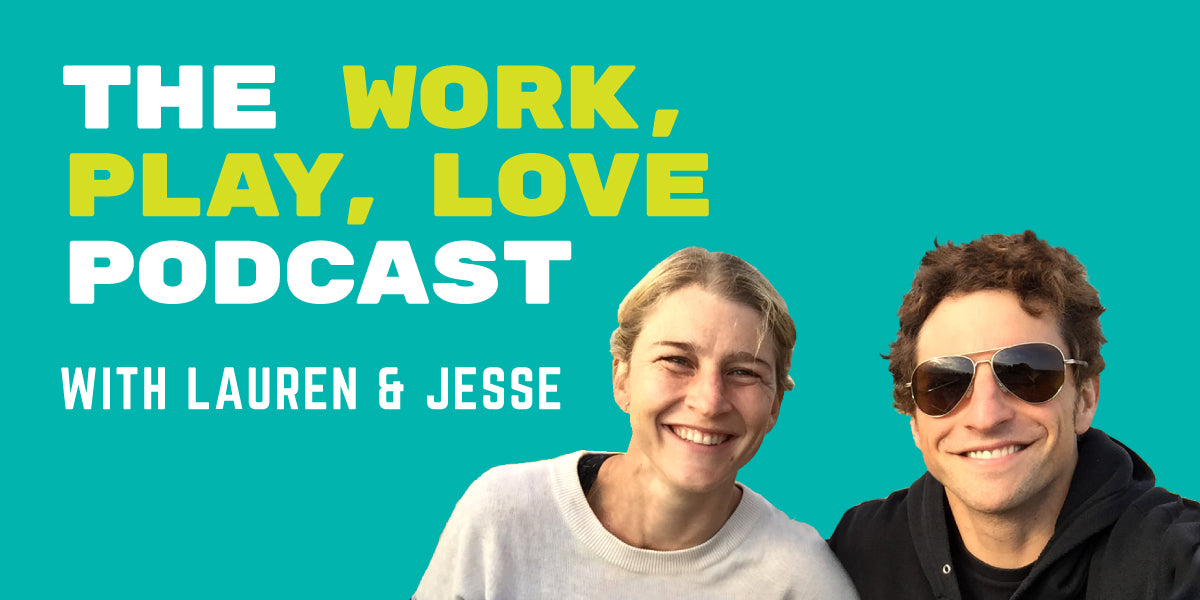

· By Sarah Conklin
27: Technique, Runger, Running Shoes
Juggling work-life balance can be a real three-ring circus, which Lauren & Jesse know first hand. Led by listener questions, this new podcast is all about sports, biz, and family. [ASK YOUR QUESTION]
27: Running Technique, Hunger Management, Favorite Running Shoes
iTunes | Spotify | Google Play | Stitcher
Description:
The holiday break is starting and 2018 is winding down. And that means a break in childcare for Zadie and Jude! So Lauren and Jesse have been busier than usual at home. However, there’s naptime and school, and that gives Lauren a few windows throughout the day to do some writing. Meanwhile, Jesse’s fresh back from the Picky Bars retreat. A full-team meeting where team members review their 2018 goals and accomplishments, and discuss how this past year will shape 2019. Jesse and Lauren catch you up on some changes coming to Picky Bars in the new year, celebrate some recent workouts, and jump into your questions. This week's Tasty Bits include: how to keep your hands warm while running and biking in the winter. How to incorporate the caffeine and sugar into your training plans. Jesse's and Lauren's favorite running shoes. And learning about why your heart rate is elevated when running in the cold. In the meat and potatoes section, Lauren and Jesse talk about running technique, hunger management during peak training, breathing techniques, and what to do when your partner is a non-athlete, or just not into the same things you are.
Tasty Bits (Quick Qs):
How do you keep your hands warm while running and biking in the winter?
Jesse: I wear gloves! Or you can also pull your sleeves over your hands. But in all seriousness, I usually go out on long rides with multiple pairs of gloves. I have a ton of gloves rated for every type of weather imaginable from Descente. I pick a primary pair, and bring a backup. An hour into a long bike ride, your first pair of gloves can really start to get cold, so I’ll switch to my backup gloves.
Lauren’s answer was a bit more sophisticated: the kind of gloves you wear matters a lot! If you’re having trouble keeping your fingers warm, wear mittens instead of gloves. Next, make sure to consider the construction and materials of the gloves/mittens. I find that if there’s a plastic or foil-type material stitched into the lining, it’s far more insulating than other designs, and keeps my hands much warmer. The Super Puff mittens by Oiselle have never failed me.
Jesse, being that you are sponsored by Red Bull, how do you incorporate the caffeine and sugar into your training plans?
Jesse: I believe in balanced eating, but there’s definitely a time and place for straight sugar and caffeine during a race or a high-intensity workout. For me, I find that I incorporate Red Bull (or other sources of sugar and caffeine) when my body is spent and my glycogen stores are depleted, like toward the end of a race or a period of intense effort. This might be in the last 30-60 minutes of a long race—so I can ride the spike of the caffeine, but still finish the race or the workout before the inevitable crash.
Lauren: There are times when I try to optimize everything and make excellent nutrition choices, but the reality is that when the fire’s burning hot, it’ll melt just about anything. So when I’m exercising, when I’m in the thick of it, when my metabolism is churning, I don’t worry as much about what I am going to eat. In the aftermath of a good workout or a race, that’s a good time for cookies.
What are your favorite running shoes?
Lauren: My go-to shoes are the Brooks Launch road-running shoes. I’m on my 7th pair, I think. And for tempo work, mid-range workouts, or if I just want a more responsive, lighter-weight shoe, I wear Adidas Tempo. Lastly, I wear Adidas Boston as my workout flat. I got nothin’ for you on spikes.
Jesse: I was a Nike guy for a long time, and in college I got really used to the Pegasus. So I look for Pegasus-like shoes even though I haven’t actually worn Pegasus in a few years. Right now I wear a Nike Structure because there’s a bit more stability inside. I was running in the Nike Zoom Fly for a little bit, but found that I was rolling inside a bit, and my ankles started to hurt. I did race in the Nike Zoom Vaporfly 4%, and it’s definitely a really fast shoe and a great shoe to race in, but I think it’s a risky shoe for anything other than a race because I found it rolls me way inside (Lauren has heard the same feedback from multiple people). I will say I also do a ton of training in the Brooks Launch—that’s a great shoe for training.
I’ve noticed that my heart rate, when running, is higher when it’s cold outside. Do you know if there’s a correlation between cold weather and higher heart rates?
Lauren: Well that would make sense to me. Our blood is the mechanism by which we maintain our body temperature, and your heart rate determines how you get that warm blood to your tissues. So would make sense to me that the heart rate would be elevated to get more warm blood to your extremities when it’s cold out. The same goes for the heat—any time your body needs to work harder to maintain your 98.6 degree temperature, your heart rate is going to fluctuate. In fact, in all of my years of running and coaching, I notice that any conditions outside of optimal running weather have an effect on the heart rate. For example, when I ask my runners to do heart-rate based tempo work, where they need to run at a specific heartrate, their pace is always slower if it’s hotter or colder than ideal running conditions.
Jesse: All of that makes sense to me. I’m not a physiologist, but from an engineering/energy-use standpoint, you would use more energy in the cold or the extreme heat. I’m with Lauren.
The Meat and Potatoes:
In a previous podcast, Lauren mentioned that, as a coach, she always makes sure her athletes have good running technique before diving into training. I’ve been funning for 15+ years and I’m always looking to improve. What does good running technique look like?
Lauren: First, I’d recommend picking up Jay Dicharry’s books (on Velopress or Amazon). He is an expert physical therapist and researcher who’s been hired by many shoe companies to consult on product design. He operates REP Lab out of Bend, OR, which is an international destination for elite athletes to work on biomechanics.
The way I can best describe proper running technique is to say that it’s about recruiting the proper muscles at the proper time. So proper running is first anchored in trans abdominis, all the fine muscles in your feet are reacting to the ground before the six-pack abs or the big quadriceps take over. So it may not look much different to the untrained eye, but your coach or a physical therapist who understands running should be able to see. A tell-tale sign of improper technique is if you have a hitching of your hips up and down on each side when you’re running—and your shoulders and head will follow this, generally. Another book that I really liked that helped me connect to, and pay attention to my body when running is Chi Running.
Jesse: I’ve spent a lot of time around really great runners, and so I can tell immediately whether someone has good running form or not. What I find is that most folks who are inexperienced runners or who don’t have good form, they generally take too long a stride. They reach too far in front of themselves with their stride, causing them to land on their heel rather than their mid-foot. To combat this, you’ll want to have proper knee drive, where the knee drives upward rather than forward. If your knee is driving too far forward, your leg and foot will follow and will extend too far forward with each stride.
Another thing is hip, or pelvic placement. You want your hips, pelvis, to be level. You don’t want to be thrusting your hips forward. And all of these things are related, so if you’re leading too much with your stride, chances are you’re thrusting your hips too much as well.
Lastly, I see a lot of folks who don’t stand up straight enough. They kind of run hunched over, or with a curved back. Again, this is kind of connected to a tilted pelvis. But good runners are generally standing straight, with their body tilted slightly forward.
Lauren: Yeah, from the crown of your head to the bottom of your heel should be a straight line.
I’m training for a marathon and I’m finding that I am hungry all. the. time. How do you manage nutrition and hunger during periods of peak training?
Lauren: It sounds like you need to adjust the timing of your meals. When you allow yourself to get too hungry, it becomes harder to hear your inner voice that lets you know you’re satiated.
Jesse: Yeah, there’s a physiological thing that happens that makes your body want to store your calories while you can. You’re getting a message from your body that’s saying “hey, we need to store calories here,” even when you might not actually need to, and that’s why you’re feeling hungry a lot.
Lauren: So I would advise you to start working on taking in calories while you’re exercising. Especially considering your mileage is going to go up and up and up. Start trying calorie drinks or gels or blocks to keep filling your tank while you’re depleting energy stores on your run. The goal doesn’t need to be calorie for calorie replacement, you just don’t want to let yourself get quite so low. And then right after you finish a workout, you need to immediately replenish with a carb-heavy energy source. Either a meal, or a protein shake or other drink to get calories and carbs in your body right away, so you don’t create these starvation signals in your body. Then when you sit down to your next meal—which should be in about an hour after your workout (if you can!)—you’ll be able to make some better more well-rounded decisions. You also need to make sure that you’re just getting a lot of carbohydrates. That’s going to stop the hunger signals.
Jesse: I agree with everything Lauren’s described here. In college I went way too long after workouts to eat. It feels good to do a hard workout—squeeze everything out of the sponge— and then go hours feeling a little hungry. But then later on, after you’ve already eaten your dinner or your next big meal, you won’t feel satiated. Usually if I’m in a workout that is 60-70 minutes long, I have a bar in the middle of it, and I also have a bar immediately after the workout—200 calories, mostly carbs, some protein, some fat. And then, like Lauren said, I try to eat within 60 minutes of the workout.
Lauren: Yes, fuel appropriately around your workouts – before, during, and after. And pay attention to your body—do you feel good and are you able to do what you want to do with your body. If so, the number on the scale doesn’t matter, the changes in your body don’t matter. But if you’re feeling like you’re starving and having out of control eating, you may not be headed in the right direction with your training and nutrition. Use some of these tips to see if they help!
Have either of you ever dated a non-athlete? That’s where I am right now. I try my best to balance my relationship with sport and my relationship with my girlfriend, but I feel like she sometimes holds it against me that I need to train instead of lounge around on weekends. Any tips on dating a non-athlete?
Lauren: You should continue to listen to your partner’s needs, but you also need to help your partner learn the language of the sport that you love. If your partner can’t adapt, can’t learn the language of your sport, can’t become a cheerleader for you in that sport it’s going to be a significant challenge—and they may not be the right person for you. A partner doesn’t need to know all of the minutiae of your sport, but if it’s something important to you, they should be able to adapt and support you in your pursuits in the ways that you need.
Jesse: Yes, I have dated a non-athlete. And I think it’s hard. If athletics is important to you and it’s a big part of your life, you hope that your partner supports it, even if they don’t understand it. And that’s it! Another thing is acknowledging whether your significant other has something that they’re interested in, and checking in with yourself to see if you’re supporting their interests or not. I think every healthy relationship has things that you have in common and things that you don’t! And that can be fine as long as you are supportive of each other in your interests.
Lauren: Another thing to consider is that it can be harder for women to state what they need due to socialization. That’s a generalization, perhaps, but I’ve found it to be supported by some evidence in my experience. So even though you may feel like you’re addressing your partner’s needs, they may not have fully voiced their needs. So it’s important to check in. Ask. Ask what’s important to them, what they like to do, and get those things on the calendar so your partner knows that their needs are important to you and that the calendar isn’t going to get completely filled up with your sport adventures.
Is breathing really loud during workouts normal?
Lauren: Check out this great book by Budd Coates. I talk about some of his techniques during running retreats. His work outlines a way to maintain synchronicity between your movement and your breath. Breathing rhythmically can be effective in controlling your breath during workouts. For example, when you’re running slow, you inhale for four steps and exhale for four steps. But when your speed increases, so does your respiration, so an inhale for two steps and an exhale for two steps may be a better rhythm during periods of max intensity. When your breathing is more controlled, you reduce the risk of cramping, you reduce the risk of panic responses while working out hard.
If you find that you’re having trouble finding a rhythm, let it go and just breathe when your body wants. Another thing to try is keeping your mouth open wider than may be…attractive. But the last thing you want is to have a closed mouth where you’re breathing through the equivalent of a straw. If you find that you’re wheezing, if that’s part of the loud sound, you may be having an asthma response, and it may be worthwhile speaking to a doctor.
Jesse: It sounds to me like you may not be breathing enough! I agree with everything Lauren says here. I breathe very rhythmically with my stride. So when I go faster my breathing increases, and when I slow down, I’m breathing once every three or four strides.
As always, submit your work/play/love question at pickybars.com/workplaylove - Thanks for listening!






